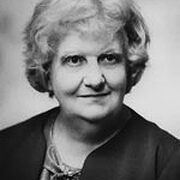Frances A. Yates (1899–1981)
Autor von Gedächtnis und Erinnern Mnemonik von Aristoteles bis Shakespeare
Über den Autor
Bildnachweis: Warburg Institute
Reihen
Werke von Frances A. Yates
Majesty and magic in Shakespeare's last plays : A new approach to Cymbeline, Henry VIII and the Tempest (1975) 57 Exemplare
Les Dernières pièces de Shakespeare 1 Exemplar
a arte da memória 1 Exemplar
The religious policy of Giordano Bruno 1 Exemplar
Giordano Bruno's conflict with Oxford 1 Exemplar
Cabbala e occultismo nell'età elisabettiana 1 Exemplar
Zugehörige Werke
Getagged
Wissenswertes
- Rechtmäßiger Name
- Yates, Frances Amelia
- Geburtstag
- 1899-11-28
- Todestag
- 1981-09-29
- Begräbnisort
- Claygate Churchyard, Claygate, Surrey, UK
- Geschlecht
- female
- Nationalität
- Groot-Brittannië
- Geburtsort
- Portsmouth, Hampshire, Engeland, Groot-Brittannië
- Sterbeort
- Claygate, Surrey, Engeland, Groot-Brittannië
- Wohnorte
- London, Engeland, Groot-Brittannië
- Ausbildung
- University College London (BA | 1924 | MA | 1926 | D.Litt | 1965)
Warburg Institute - Berufe
- historicus
hoogleraar
letterkundige
redacteur - Organisationen
- Warburg Institute, University of London
- Preise und Auszeichnungen
- Dame Commander, Order of the British Empire (1977)
Fellow, British Academy (1967)
Wolfson History Award (1973)
Member, Order of the British Empire (1972)
Foreign Member, Royal Netherlands Academy of Arts and Sciences (1980)
Mary Crawshaw Prize (1935) (Zeige alle 11)
Marion Reilly Award (1943)
Foreign Honorary Member, American Academy of Arts and Sciences (1975)
Premio Galilio Galilie (1978)
Fellow, Lady Margaret Hall, Oxford
Fellow, Warburg Institute - Kurzbiographie
- Frances A. Yates received a master's degree in French theatre from London University in 1926. She taught at North London Collegiate School until 1939. A small inheritance from her father gave her the freedom to conduct some independent study and at some point she discovered forgotten documents in the London Public Records Office about the late 16th-century linguist and translator John Florio. In 1934, she published her first book, John Florio: the Life of an Italian in Shakespeare's England, which laid the groundwork for the rest of her prize-winning career as a scholar of the Renaissance. She also taught at the Warburg Institute of the University of London for many years.
Mitglieder
Rezensionen
Listen
Auszeichnungen
Dir gefällt vielleicht auch
Nahestehende Autoren
Statistikseite
- Werke
- 27
- Auch von
- 1
- Mitglieder
- 4,032
- Beliebtheit
- #6,246
- Bewertung
- 4.2
- Rezensionen
- 55
- ISBNs
- 161
- Sprachen
- 12
- Favoriten
- 20

















